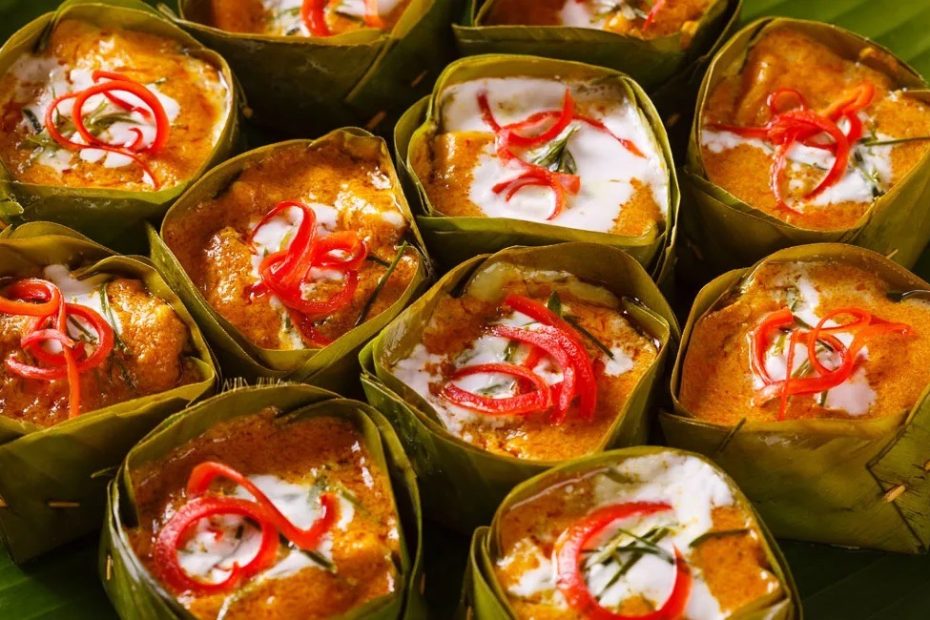Cambodian Amok is a culinary masterpiece that encapsulates the nation’s heritage and invites diners on a sensory exploration like no other. Cambodia boasts a cuisine that is as rich in history as it is in flavors. Khmer cuisine, with its harmonious blend of aromatic spices, fresh ingredients, and cultural traditions, offers a sensory journey into the soul of the nation.
What is Cambodian Amok?
Cambodian Amok is a revered culinary delight that stands at the crossroads of tradition, culture, and flavor in Cambodian cuisine. It is a dish that encapsulates the essence of Khmer cooking, characterized by its harmonious blend of aromatic spices, tender protein, and creamy coconut milk. Often referred to as “amok trei” when made with fish, Cambodian Amok is a steamed dish that boasts a mousse-like texture, creating a unique gastronomic experience.

Cambodian Amok
At its core, Cambodian Amok is a type of curry that showcases the art of balance. The flavors are carefully orchestrated, with fragrant ingredients such as lemongrass, galangal, kaffir lime leaves, and turmeric coming together to form a potent spice blend known as “Kroeung.” This spice paste infuses the dish with layers of complexity and a distinct Cambodian aroma.
The dish typically features a protein element, often fish (trei), which is marinated in the Kroeung and then gently steamed. The use of banana leaves for wrapping and steaming not only imparts a subtle earthy fragrance but also contributes to the presentation of the dish. As the dish steams, the coconut milk combines with the spices, creating a rich and aromatic sauce that envelops the protein.
A Taste of Cambodia’s Culinary Heritage
Cambodian cuisine is a treasure trove of flavors, influenced by its history, geography, and cultural diversity. From aromatic spices to the use of fresh ingredients, every dish carries a story of Cambodia’s past and present. And at the forefront of this culinary narrative stands Cambodian Amok.
You may check: Best Cambodian Foods You Must Try
Amok Origins and Evolution
Amok’s roots can be traced back to the Khmer Empire, a civilization that left an indelible mark on Cambodia’s culture and traditions. In ancient times, Amok was a dish enjoyed by royalty and commoners alike, symbolizing unity and celebration. Over the years, the dish has evolved, adapting to changing tastes while retaining its fundamental essence.
While fish is the traditional protein used in Amok, the dish has also evolved to include variations such as chicken, beef, tofu, and even vegetables. These adaptations showcase the versatility and creativity inherent in Khmer cuisine, while still upholding the foundational principles of flavor harmony.
Culinary Masterpiece: Cambodian Amok
Among the jewels of Khmer cuisine, Cambodian Amok stands out as a culinary masterpiece. This iconic dish is a true reflection of Cambodia’s cultural heritage, celebrated not only for its delectable taste but also for the stories and history it encapsulates. To truly appreciate Cambodian Amok, one must delve into its cultural and historical context. Understanding the significance of this dish within Cambodian society, as well as the role it has played in shaping culinary traditions, adds depth to the experience of savoring its flavors.
The Essence of Cambodian Amok
Cambodian Amok traces its origins back to the ancient Khmer Empire, where it was enjoyed by royalty and commoners alike. Over the centuries, the dish has evolved while retaining its core essence—a delicate balance of flavors that evoke the spirit of Cambodia.
Amok isn’t just a dish; it’s a cultural symbol. Often prepared and shared during festive occasions and family gatherings, Amok brings people together to celebrate life’s moments. Its presence on the Cambodian table reflects a deep-rooted connection to tradition and community.
The Culinary Journey of Cambodian Amok
Savoring Cambodian Amok is an experience that transcends the plate. Each bite carries the legacy of the Khmer Empire, the warmth of Cambodian hospitality, and the passion of the chefs who continue to uphold its traditions.
1. Essential Ingredients
At the heart of Cambodian Amok lies a harmonious ensemble of ingredients: tender fish or chicken, fragrant spices, rich coconut milk, and an array of fresh herbs. This combination transforms the dish into a flavorful and aromatic delight.
You may check: Best Cambodian Ingredients In Khmer Cuisine
2. The Art of Kroeung
Kroeung, a traditional Khmer spice paste, is the soul of Amok. Its carefully balanced blend of lemongrass, galangal, turmeric, and other spices infuses the dish with layers of complex flavors, making each bite a journey of taste sensations.
Nowaday you can find ready made Khmer Kroeung so easily. KREUNG HLOUNG is one the best Cambodian enterprises that stands as a premium emblem of a Cambodian-originated culinary enterprise. Their portfolio features four distinct offerings: Crimson Curry Paste, Amok Blend, Honey-infused BBQ Sauce, and Zesty Chili Sambal Sauce.
Every single one of their creations is meticulously fashioned from entirely fresh ingredients, assiduously supervised by laboratory and food safety experts, and housed in user-friendly, top-tier packaging designed for a serving of two. Guided by the ethos of ‘Delightful, Fresh, and Convenient,’ their aspiration is to introduce an essential contemporary culinary companion to the vibrant landscape of Cambodian cuisine.
3. Steamed to Perfection
Cooking Cambodian Amok is an art that involves wrapping the marinated ingredients in banana leaves and gently steaming them. This method locks in the flavors and allows the dish to absorb the subtle aromas of the leaves.
4. Presentation and Garnishing
The presentation of Cambodian Amok is a testament to the country’s reverence for aesthetics. Served in banana leaf cups or ceramic dishes, the dish is often adorned with a sprinkle of fresh herbs or a drizzle of coconut cream, inviting both the eyes and the palate.
5. The Modern Evolution of Cambodian Amok
As Cambodia embraces modern influences, Amok has also experienced innovative interpretations. Contemporary chefs infuse new ingredients and techniques while preserving the dish’s core flavors, catering to evolving palates. In bustling markets and upscale restaurants alike, Cambodian Amok is both a nostalgic comfort food and a culinary delight. Its presence on menus across the country underscores its timeless appeal.
Cambodian Amok Trei Recipe
Amok Trei, a timeless Cambodian delicacy, encapsulates the rich flavors and aromatic spices that define Khmer cuisine. This recipe takes you on a journey to recreate the authentic flavors of Amok Trei, allowing you to savor the essence of Cambodia in the comfort of your own kitchen.
Ingredients:
For the Kroeung (Spice Paste):
- 2 stalks lemongrass, chopped
- 2-3 kaffir lime leaves, thinly sliced
- 2 cloves garlic
- 1 thumb-sized piece of galangal, peeled and sliced
- 1 thumb-sized piece of turmeric, peeled and sliced (or 1 teaspoon turmeric powder)
- 1 small shallot, chopped
- 1 teaspoon shrimp paste (belacan)
For the Amok:
- 500g firm white fish fillets (such as cod or snapper), cut into bite-sized pieces
- 1 can (400ml) coconut milk
- 2 tablespoons fish sauce
- 1 teaspoon sugar
- 1 tablespoon oil
- Banana leaves, cut into squares for wrapping
- Fresh cilantro leaves, for garnish
Instructions:
- Prepare the Kroeung: a. In a mortar and pestle or a food processor, combine all the Kroeung ingredients. b. Grind or process into a smooth paste. Set aside.
- Marinate the Fish: a. In a bowl, mix the fish with half of the prepared Kroeung paste. Allow it to marinate for at least 30 minutes to infuse the flavors.
- Prepare the Amok Mixture: a. Heat oil in a pan over medium heat. Add the remaining Kroeung paste and sauté until fragrant, about 2-3 minutes. b. Stir in the coconut milk, fish sauce, and sugar. Let the mixture simmer gently for about 5 minutes, allowing the flavors to meld.
- Assemble and Steam: a. Place a banana leaf square in a small bowl or ramekin to create a cup. b. Place a few pieces of marinated fish in each banana leaf cup. c. Pour the coconut milk mixture over the fish, filling the cups about three-quarters full. d. Fold the banana leaves to cover the fish and create a sealed packet.
- Steam the Amok: a. Place the banana leaf packets in a steamer and steam for about 20-25 minutes, or until the fish is cooked through and the flavors are well infused.
- Serve and Garnish: a. Carefully unwrap the banana leaf packets and transfer the steamed fish and sauce to serving bowls. b. Garnish with fresh cilantro leaves for an aromatic touch.
- Enjoy the Culinary Journey: a. Serve the Amok Trei hot with steamed rice. The fragrant coconut milk, aromatic spices, and tender fish create a symphony of flavors that celebrate the heart of Cambodian cuisine.
Tip: If banana leaves are not available, you can use parchment paper to wrap the fish instead.
You may check: Exploring The Best Cambodian Desserts
Final Thought: A Culinary Heritage Unveiled
Cambodian Amok isn’t just a dish; it’s a testament to Cambodia’s history, resilience, and creativity. It’s a culinary journey that allows us to taste the past, appreciate the present, and celebrate the future. As you indulge in the delicate layers of flavors, remember that Cambodian Amok is more than food—it’s an expression of culture, a connection to tradition, and an invitation to explore the richness of Cambodia’s culinary heritage.



